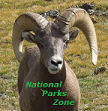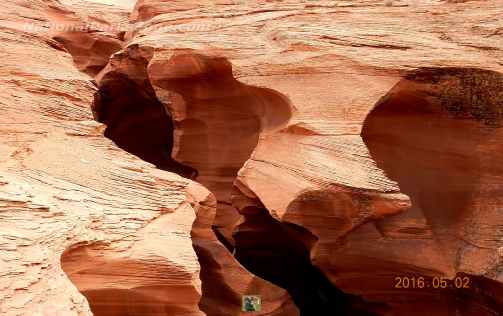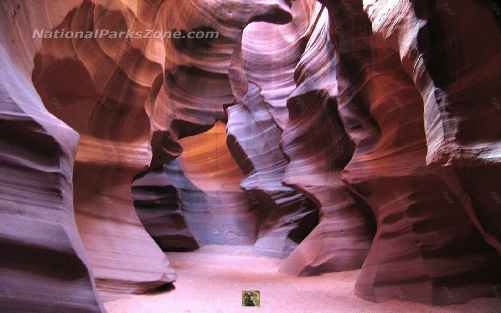Antelope Canyon Navajo Tribal Park
Take a guided tour of Arizona's often-photographed Antelope Canyon. You’ll see a magnificent slot canyon of unparalleled beauty.
Arizona
2005, 2016, 2017
A Magnificent Slot Canyon
Antelope Canyon outside of the Page, Arizona is the most famous slot canyon in the southwest. Its wind and water sculpted walls have been seen by many in both amateur and professional photographs.
Both of the canyons are on Navajo tribal lands and no one is allowed into the canyons, or the surrounding lands, without a Navajo guide. The tours are licensed and operated by the Navajo and provide both revenue and jobs. Tours are generally in the $40-$90 range depending on time, which is usually between 1 and 1-1/2 hours, and options chosen.
Both the Upper Antelope Canyon and the Lower Antelope Canyon were formed mostly by rain with perhaps a little help from the wind. During the ‘monsoon’ season, June through September in Arizona, heavy thunderstorms, often as much as 10 or 15 miles away, can send huge amounts of water funneling down washes where they reach these very narrow canyons and become a torrent of tremendous force. Because of this the Navajo operators pay close attention to the weather in the surrounding area.
In 1997, 11 tourists were killed by a flash flood that sent water gushing into Lower Antelope Canyon. The only survivor was the tour guide who was found naked on a ledge having survived by wedging his foot into a crevice. His clothes were torn off by the force of the deluge. The body of one tourist was never found despite multiple searches for it. It was probably washed into Lake Powell and buried under sediments carried by the flood. There are places in the canyons where you can see tree trunks wedged above you indicative that more than just water comes through in a flash flood. It is mud, silt, rocks, vegetation and tree trunks in a thick soupy mix and you are not going to swim through it.
Careful attention to the weather and other measures were instituted as a result of this tragedy and it has never been repeated (and had not happened before this 1997 event).
Upper Antelope Canyon is accessed by a truck ride from Page that, once leaving the main road, travels down a wide sandy wash to the mouth of the canyon. You enter at ground level, walk along the flat canyon floor, and exit the same way you entered. It is the more popular tour. You can see in the photo gallery the assemblage of tour vehicles at the canyon’s entrance.
Lower Antelope Canyon can be reached via car. It is on highway 98 and across the road from a coal-fired power plant. There’s a small ‘visitor center’ building selling tickets and snacks. The tours assemble along the side of the building and walk to the steel stairway that leads down into the canyon. The exit is interesting because you ascend some stairs and short ladders to leave out of what looks like a crack in the sandstone behind the building. It is just about three feet wide and you can see a photo of place where you exit the canyon in the photo gallery. When you walked to the entrance stairway with your group you passed near it and weren’t even aware it was there.
Photography is difficult in the canyons. With lots of tour groups it is difficult to get shots without people in them (except for ‘looking up’ shots). The lighting conditions also make it a difficult photo shoot for non-professionals. It is entirely natural light coming in from above. The canyon width can range from a veritable slit that a man could jump across to something not very much wider. With 120 foot high walls the light can vary from bright in some places to dusk-like in others. The tour guides were very helpful. They knew which settings to use on iPhones and Androids that were best to improve our photos. They also do not allow tripods or selfie sticks, among other things, on the regular tours since, due to the amount of people, they have to keep things moving.
An alternative is a photo tour which typically had less people and more time in the canyons. These had shut down in 2019 due to negative reviews and overcrowding but some operators are currently selling these specialized tours. They do seem to offer more time but cost more money. Tripods are only allowed on the photo tours. If this kind of tour interests you then it is advisable to call and find out if and when they are available and the details regarding time in the canyon and restrictions.
The best time to visit Antelope Canyon is April, May, October, and the beginning of November. At this time it is cooler, but not cold, and since the children are in school, less crowded. It is hotter in summer and significantly more crowded. You can still enjoy the canyons any time but getting a photo without someone else’s family in the picture will be more challenging.
Generally it is advisable to book a tour in the morning. Morning tours are obviously the coolest time to visit Antelope Canyon. As a bonus, if you are visiting Lower Antelope Canyon, these morning slots offer the best chances for photos without people in them. The earlier the better since the crowds build as the day wears on. However, in Upper Antelope Canyon, the midday sun can send shafts of light into the canyon that illuminates the narrow orange and gold sandstone walls.
Afternoon tours during the June to September monsoon season have the best chance of being canceled due to weather or the threat of imminent rain.
Antelope Canyon can get below freezing in the winter. Snowstorms happen every winter, and winds funneling through the narrow canyon can make it feel much colder than the weather says. Snow in Antelope Canyon can be both a blessing and a curse. Heavy snowstorms close the canyon; a light dusting can add a layer of color that makes for more vivid photos. Also, on the plus side, the tour rates are lower in winter and the tours are less crowded.
Wildlife
There is no wildlife in the canyon per se. Perhaps an occasional spider. There is much to much traffic for even the usual desert creatures to find this as a habitable venue.
Lodging and Dining
There is no lodging at the canyon. All lodging and dining options can be found in the town of Page, Arizona where there are ample options for both dining and lodging.
There is just a small visitor center where souvenirs and some snacks can be bought at the entrance to Lower Antelope Canyon which is right off highway 98.
Hiking
Both the lower and upper canyons are on Navajo tribal land and access without a guide is prohibited. Guided tours can be booked online or at offices in Page, Arizona. The lower canyon is next to the highway and one can drive up to the visitor center and buy tickets there.
Other Points of Interest
On the edge of Page is the majestic Glen Canyon Dam which also is part of the Glen Canyon National Recreation Area. It was completed in 1966 and at 710 feet (220 m) it is one of the highest dams in the world. Built to tame the Colorado River it created the 186 mile long Lake Powell and provides hydroelectric power to the surrounding states. It took 17 years to fill the reservoir to its full elevation of 3,700 feet (1,100m) above sea level. There is a visitor center with interesting exhibits relating to the construction and the natural and native history of the area. There are also tours of the power plant deep in the bowels of this massive concrete structure.
A few miles away, just south of Page, is Horseshoe Bend. It is also part of the Glen Canyon National Recreation Area but it is also on Navajo land. This is, as you might expect, a horseshoe shaped bend in the Colorado River about 9 miles upstream from where the Grand Canyon begins. It was sculpted by the river about 5 million years ago.
It is certainly dramatic and beautiful and you are on the edge of a cliff overlooking the river where the river is 1,000 feet (1.6 km) below you. You reach the edge via a 1.5 mile round trip from the parking area just off highway 89. The trail was a hardened dirt and sand surface formerly but now seems to have been paved. A viewing platform has apparently been added after 2017.
Obviously extreme care are must be taken as there are no guard railings outside of the viewing platform. You are free to walk, or climb the rocks, along the edge and people have slipped and fallen to their deaths. Children must be completely under an adult’s control at all times.
On holiday or busy weekends, when the parking lot is full, visitors may have to take a shuttle to get here. There are also fly-over tours and rafting tours that take you to Horseshoe Bend. The photos in the photo gallery will show you exactly what to expect there and you can find much more information in the links below.
A few miles north of Monument Valley is Goosenecks State Park which has a couple of horseshoe bends which, in Utah, are apparently called goosenecks. Here the San Juan River meanders 6 miles, while advancing only 1.5 miles west, forming a series of goosenecks. The park is several miles off US 163. It consists of just some picnic tables a few feet from the parking area. You walk up to the edge of the 1,000 foot deep canyon and you can walk along it to view the goosenecks. It is a sun-drenched spot without a drop of shade. There are some campsites available on a first-come basis. Goosenecks is a stark wilderness of rocky canyons with Monument Valley in the distance. The page on Monument Valley has more about Goosenecks and other interesting and scenic places to visit if you are in the Monument Valley area.
Other Resources
Antelope Canyon - Wikipedia
Antelope Canyon - Visit Arizona
Upper Antelope Canyon Tours
Lower Antelope Canyon Tours
Upper and Lower Antelope Canyon Tours
Antelope Canyon Tour Operators - NationalParks.org
Guide To Visiting Antelope Canyon The Right Way
Visit Antelope Canyon - Trip Advisor
Photo Tours of Antelope Canyon
Photo Tour of Upper Antelope Canyon
Photo Tour of Lower Antelope Canyon
Horseshoe Bend and Antelope Canyon Tours
Horseshoe Bend - Wikipedia
Helicopter and Airplane Tours of Page Area Attractions
Goosenecks State Park - Utah State Parks Website
Glen Canyon Dam - Wikipedia
Glen Canyon Dam Guided Tours - NPS.gov
N*P*Z
Other National Parks and National Monuments Within a Day’s Drive
Grand Canyon North Rim is a 111 mile drive via highway 89A through Marble Canyon and takes about 2.5 hours. The drive takes you along the beautiful and scenic southern edge of the Vermillion Cliffs National Monument which is a wilderness of slickrock, canyons and strange buttes.
Grand Canyon South Rim is a 140 mile drive to the southwest and takes about 2.5 hours. The drive takes you along the scenic eastern edge of the Vermillion Cliffs National Monument.
Zion Canyon National Park where you can tour a half mile wide canyon with virtually sheer 2000 foot walls about 150 miles away and around a 3 hour drive to the West.
Bryce Canyon National Park You can see hoodoos and the awesome Bryce Amphiteater about 175 miles away and about a 3.5 plus hour drive. If you are a bit more adventurous there is the graded Cottonwood Road that cuts across the heart of the Grand Staircase Escalante National Monument. The scenery along Cottonwood Road is terrific and it passes by the beautiful Kodachrome Basin State Park which the Kodak Corporation was thrilled to lend its name to.
Cedar Breaks National Monument is often called a mini-Bryce Canyon and is 142 miles northwest and about a 3 hour drive.
Mesa Verde National Park Home to ancient cliff dwellings set into a beautiful mesa is about 240 miles to the East and about a 4 hour drive.
Petrified Forest National Park Home of the Painted Desert and 225 million year old petrified logs is 250 miles to the south and east and a 4 hour drive.
Canyonlands National Park A vast and incredibly scenic wilderness is both north and south of Moab, Utah which is about 270 miles and a 4.5 hour drive to the northeast of Page, Arizona.
Arches National Park has over 2000 arches including the famous Delicate Arch, Utah’s state symbol, and is about 3 miles north of Moab which makes it also about 270 miles and a 4.5 hour drive to the northeast of Page, Arizona.
Capitol Reef National Park is about a 7-hour, 320 mile drive which would pass by Bryce Canyon National Park.
Colorado National Monument A dramatic red rock canyon, outside of Grand Junction, Colorado, is about 400 miles to the east and about a 6.5 hour drive.
Black Canyon of the Gunnison National Park This spectacular canyon is 75 miles east of the Colorado National Monument. It is about 420 miles from Page and about a 7.5 hour drive.
Utah’s highway 12 was on AAA’s the list of the top ten scenic roads in America and that link will take you to a page on this website devoted to it and all the scenic places along that route which passes by Bryce Canyon.
These national monuments are on Navajo Tribal land and are as worthwhile to visit as any national park.
Monument Valley Tribal Park is about 130 miles east and about a 2 hour plus drive. This is a place that you’ve seen in any number of Hollywood westerns.
Canyon De Chelly National Monument is about 210 miles to the east and then south and about a 4 plus hour drive.
That part of southern Utah and Northern Arizona is full of scenic places. Hovenweep National Monument, Natural Bridges National Monument, the Four Corners Monument, Mexican Hat Rock and Goosenecks State Park. Valley of the Gods in the new Bears Ears National Monument, has an easy graded road that snakes for 17 miles among some beautiful formations and the Moki Dugway on highway 261 which was an old uranium mining road that travels in a series of switchbacks up Cedar Mesa. At the top of the mesa, just down the road, there’s an easy dirt and gravel road to Muley Point.
*N*P*Z*N*
*N*P*Z*
P*Z*


